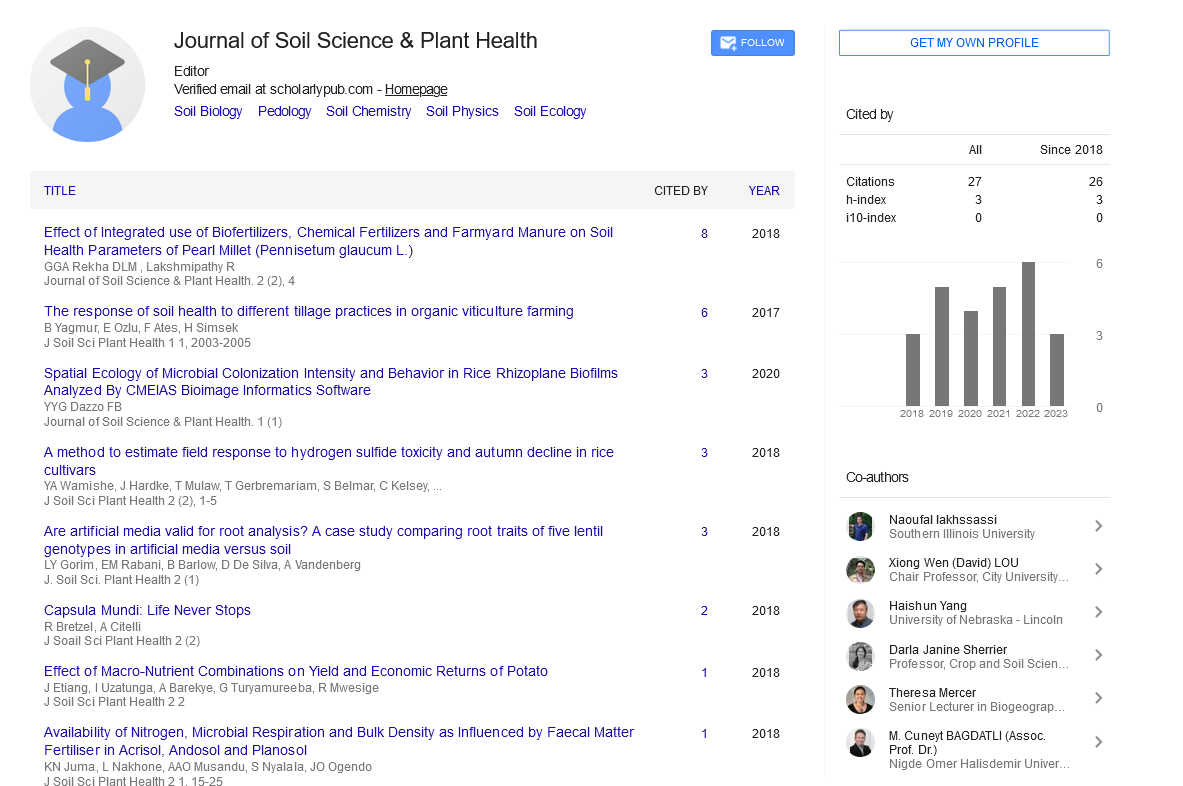Perspective, Vol: 7 Issue: 1
Historical Overview of Dynamic Pedology and Soil Sciences
Jean Cheyson*
1Department of Agronomy , Universidade Federal Rural de Pernambuco (UFRPE), Recife, Pernambuco 52171–900, Brazil
*Corresponding Author: Adamantia Nikolaidi, Oncology Clinic
Department of Agronomy,
Universidade Federal Rural de Pernambuco (UFRPE), Recife, Pernambuco
52171–900, Brazil;
E-mail: jean.chey@ufrpe.br
Received date: 27 January, 2023, Manuscript No. JSPH-23-92781;
Editor assigned date: 30 January, 2023; PreQC No. JSPH-23-92781 (PQ);
Reviewed date: 14 February, 2023; QC No. JSPH-23-92781;
Revised date: 21 February, 2023; Manuscript No. JSPH-23-92781(R);
Published date: 28 February, 2023, DOI:10.4172/jsph.10000173
Citation: Cheyson J (2023) Historical Overview of Dynamic Pedology and Soil Sciences. J Soil Sci Plant Nutr 7:1.
Abstract
Dynamic pedology, also known as soil genesis, is the study of how soils form and change over time. It seeks to understand the processes and factors that influence the formation, composition, and properties of soils. The study of dynamic pedology dates back to the 19th century, when scientists such as Vasily Dokuchaev and Hans Jenny began to explore the relationship between soil properties and their environment. Dokuchaev is considered the founder of soil science, and his work on soil formation and classification set the foundation for much of modern dynamic pedology
Description
Dynamic pedology, also known as soil genesis, is the study of how soils form and change over time. It seeks to understand the processes and factors that influence the formation, composition, and properties of soils. The study of dynamic pedology dates back to the 19th century, when scientists such as Vasily Dokuchaev and Hans Jenny began to explore the relationship between soil properties and their environment. Dokuchaev is considered the founder of soil science, and his work on soil formation and classification set the foundation for much of modern dynamic pedology.
In the early 20th century, the focus of dynamic pedology shifted to the study of soil formation and development in different environments. The work of Jenny, who developed the concept of soil catenas (sequences of soils that form on a landscape), and of William Albrecht, who studied the role of soil minerals in plant nutrition, were particularly influential during this time. In the mid-20th century, advances in technology and methodology allowed for more detailed investigations into the processes and mechanisms of soil formation. The development of radiocarbon dating, for example, enabled researchers to determine the ages of soil layers and better understand the rates of soil formation. The use of stable isotopes also provided insights into the sources and transformations of soil organic matter. In the latter half of the 20th century, the study of dynamic pedology became increasingly interdisciplinary, with researchers from fields such as geology, ecology, and microbiology contributing to our understanding of soil formation and function. Advances in molecular biology and genetic sequencing have also allowed for more detailed investigations into the microbial communities that play a critical role in soil formation and nutrient cycling. It continues to be an active area of research, with a focus on understanding the impacts of human activities on soil formation and function, as well as the potential for soils to sequester carbon and mitigate climate change. Soil science is a field of study that has been developing for centuries.
Brief overview of historical evolution
Ancient civilizations: The earliest civilizations, such as the Egyptians, Greeks, and Romans, recognized the importance of soil for agriculture and developed methods to improve soil fertility.
16th century: The first recorded observations on soil formation were made by Swiss naturalist Conrad Gesner.
17th century: European scientists such as John Evelyn, Jan Baptist van Helmont, and Jean-Baptiste de la Quintinie made significant contributions to the understanding of plant nutrition and soil fertility.
18th century: The famous Swedish scientist Carl Linnaeus classified soils based on their physical and chemical properties. Later in the century, the German geologist Abraham Werner introduced the concept of soil horizons, which are layers of soil with distinct characteristics.
19th century: The German chemist Justus von Liebig discovered the importance of nitrogen, phosphorus, and potassium in plant growth. This led to the development of synthetic fertilizers, which revolutionized agriculture.
20th century: Soil science became more interdisciplinary, incorporating fields such as geology, biology, and ecology. Soil conservation and management practices were developed in response to the degradation of soils due to erosion, nutrient depletion, and pollution.
Today, soil science continues to evolve as new technologies and research methods are developed. There is a growing recognition of the importance of soil health for sustainable agriculture, ecosystem services, and climate change mitigation.
 Spanish
Spanish  Chinese
Chinese  Russian
Russian  German
German  French
French  Japanese
Japanese  Portuguese
Portuguese  Hindi
Hindi 